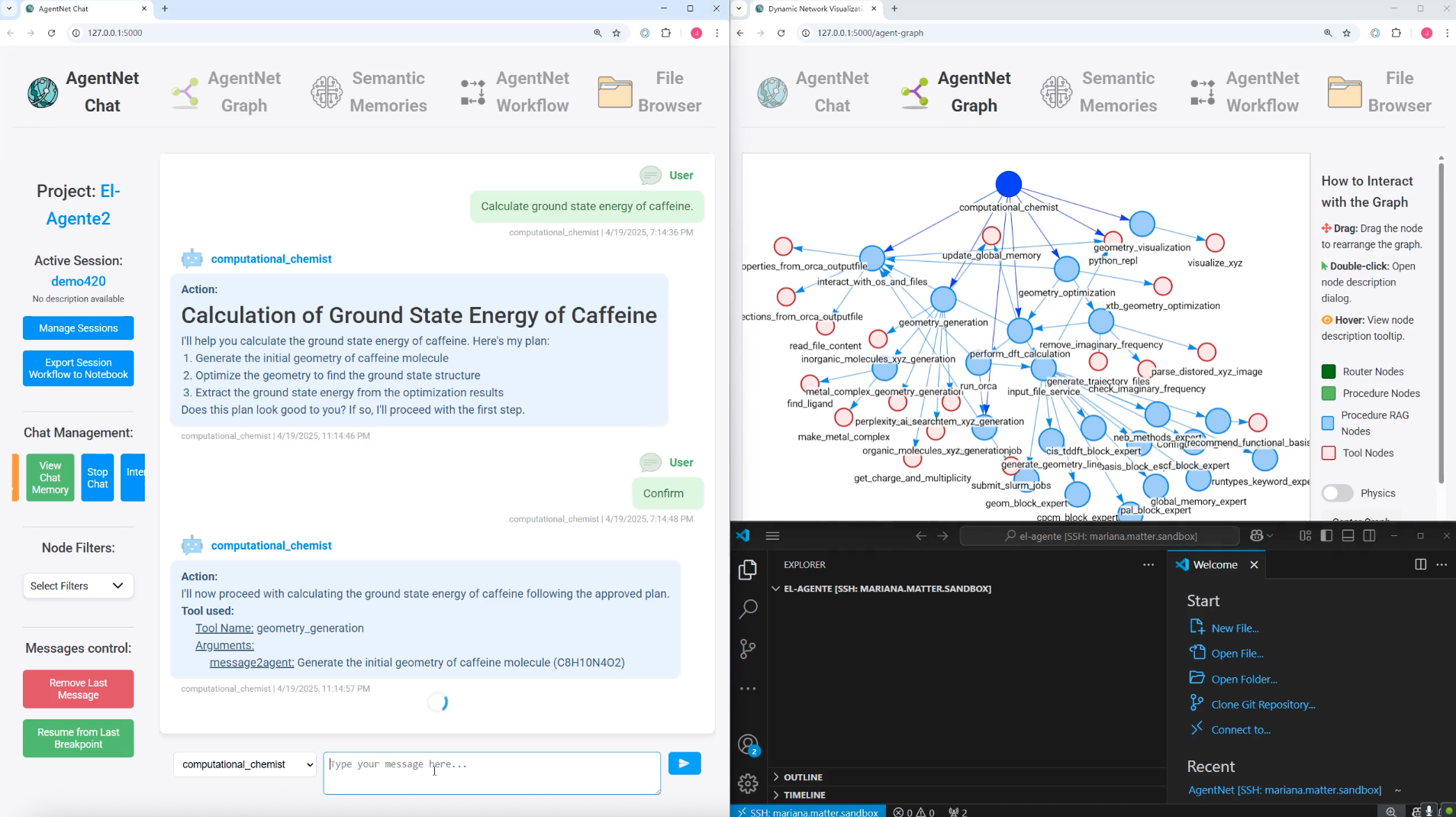Insider Brief
- A new study introduces El Agente Q, an AI agent that uses large language models to autonomously interpret natural language prompts and carry out quantum chemistry computations.
- Developed by researchers from NVIDIA, the University of Toronto, the Vector Institute, and the Acceleration Consortium, the system successfully plans and executes multi-step chemistry tasks by combining language reasoning with specialized scientific tools.
- While it performs well across benchmarked exercises, the system still struggles with edge cases and lacks true physical understanding, underscoring the need for better tool integration, error handling, and deployment-ready infrastructure.
A new study introduces a language-agent framework that translates plain English into quantum chemistry computations, signaling a shift toward more accessible and automated scientific workflows.
Researchers have built an AI system called El Agente Q that integrates large language models (LLMs) with quantum chemistry software to autonomously plan, execute, and explain computational chemistry tasks. The system is capable of understanding general scientific queries, breaking them into step-by-step procedures, selecting the right tools, and solving quantum mechanical problems with minimal human intervention.
Posted on the pre-print server arXiv, the researchers, which include scientists from NVIDIA, the University of Toronto, the Vector Institute for Artificial Intelligence and the Acceleration Consortium, details how this LLM-based agent outperforms earlier attempts at scientific automation by combining flexible natural language reasoning with domain-specific knowledge about molecules, quantum mechanics, and computational chemistry packages. The work demonstrates the growing potential of foundation models to take on scientific roles traditionally reserved for human experts.

“LLMs have great potential to transform the way we do science,” Alán Aspuru-Guzik, principal investigator at the Matter Lab, director of the Acceleration Consortium and Senior Director of Quantum Chemistry at NVIDIA said in a statement. “El Agente democratizes access to computational chemistry, an important step that will lead to even greater innovation in areas like drug discovery and materials science.”
Just Chatting About Chemistry
At the core of El Agente Q is a multi-agent architecture driven by a general-purpose LLM. Think of it as team of different AI programs that work together, each doing a specific job, to complete a complex task more effectively.
When given a natural language prompt — let’s say, for example: “What is the dipole moment of methanol?” — the system first parses the request, then decomposes it into subtasks: identifying the molecular structure, selecting a quantum chemistry method, running a calculation and interpreting the result.
Unlike prior tools that required users to structure inputs in code or fixed formats, El Agente Q allows users to engage in freeform dialogue. The model adapts to requests whether they’re framed as formal queries or informal, exploratory conversations.
The agent system includes modules for chemical data retrieval, file handling, geometry optimization, basis set selection and even LaTeX rendering for scientific reporting. These capabilities are orchestrated through a central planning module that tracks progress and adjusts actions dynamically based on intermediate outcomes, such as recognizing when a calculation fails and rerouting the workflow.
Benchmarks Show Competence Across Tasks
To evaluate the system’s effectiveness, the researchers benchmarked El Agente Q on six university-level course exercises and two case studies, which demonstrated robust problem-solving performance — averaging greater than 87% task success — and adaptive error handling through in situ debugging, the team writes.
The tasks spanned categories such as structure retrieval, property prediction, file format conversions and numerical estimations. For instance, when asked to estimate the HOMO-LUMO gap — a key electronic property — for a novel molecule, El Agente Q correctly selected an appropriate computational method, constructed the input files, ran the simulation, and returned the result with units, all without human assistance.
While some tasks remained challenging — especially those involving long-range planning or complex physical intuition — the system demonstrated strong zero-shot capabilities, meaning it could generalize to tasks it was never explicitly trained on. It also showed resilience when prompts were noisy, incomplete, or asked in casual language.
Modular Design Enables Generalization
The strength of El Agente Q lies in its modular and extensible design, according to the team. It treats each scientific tool — whether it’s a geometry visualizer or a Schrödinger solver — as a callable function, embedding each into the LLM’s operating environment. These functions are exposed to the language model through structured documentation and examples, allowing it to learn how to use them from context.
To make this possible, the authors developed a set of tool APIs specifically designed for chemistry workflows. These included wrappers for simulation engines, chemical databases, text-to-structure converters and plotting utilities. The model learns to reason about when and how to invoke each tool, a capability that could be referred to as a function calling composability.
An agent memory system retains a record of each step taken, which the model uses to reflect on past actions, recover from errors, and revise its approach as needed. In this sense, El Agente Q mimics a human researcher working through a lab notebook, except the notebook is a dynamic, AI-driven log of reasoning steps and computational outputs.
Limitations Remain in Edge Cases
Despite promising results, the study acknowledges some limitations and areas for future work. For example, while the model handles many standard chemistry tasks well, it still falters in edge cases — particularly when reasoning about subtle physical principles or when errors in external tools propagate into the workflow.
The language model also lacks true physical understanding. Its success depends on learned associations rather than derivations from first principles. For example, it might know that a certain basis set is typically used with a specific molecule, but it doesn’t reason about why. This poses risks in high-stakes scientific applications where precision is critical.
The researchers suggest that reliance on third-party tools means that errors in those packages, or their compatibility with the agent, can obviously affect outcomes. The paper notes that further development will need to include fault tolerance, version control and integration with more diverse simulation backends.
The system currently operates in a simulated environment. While it automates file creation, calculation and result parsing, deploying such an agent in real lab settings or with proprietary workflows would require tighter integration with secure data and compute infrastructures.
Toward a Future of AI-Led Discovery
The authors suggest that El Agente Q is a step toward a broader vision: AI systems that act as collaborators in scientific discovery. By bridging the gap between human language and quantum mechanics, the agent offers a proof of concept for automated science assistants capable of scaling expert knowledge across labs and disciplines.
Future research will focus on expanding the toolset, improving error handling, and incorporating uncertainty quantification—an essential feature for building scientific trust. The team also plans to integrate visualization tools, database search capabilities, and real-time feedback from users to make the agent more interactive and intuitive.
Beyond chemistry, the underlying architecture could be adapted to other domains that combine structured data, simulation engines, and domain-specific reasoning — such as materials science, molecular biology or even climate modeling.
The success of El Agente Q underscores a broader trend: the convergence of AI with physical science. As foundation models become more powerful and context-aware, they may not just automate science — they may help reinvent how it is done.
“El Agente was created by a large multidisciplinary team of enthusiastic and talented researchers in record time,” says Varinia Bernales, director of research at the Matter Lab. “It showcases how collaboration allows innovation to unfold at a faster pace.”















